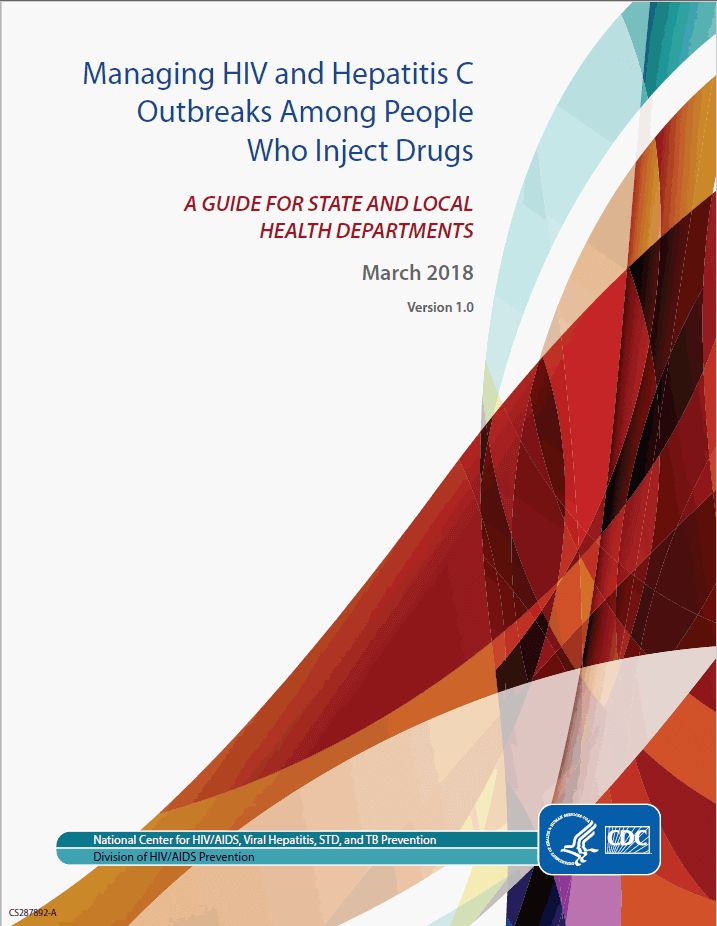From CDC.
By Corinna Dan, R.N., M.P.H., Viral Hepatitis Policy Advisor
CDC has released Managing HIV and Hepatitis C Outbreaks Among People Who Inject Drugs: A Guide for State and Local Health Departments, a guide to help state and local health departments plan for an outbreak of HIV or hepatitis C among people who inject drugs. The guide outlines strategies to detect and investigate a possible outbreak and includes considerations for developing an outbreak response plan to minimize the impact of the outbreak on the community and stop further transmission.
 The current opioid epidemic has increased the number of people who are injecting drugs in the U.S., and that has substantially increased the risk of transmission of blood-borne viruses, including HIV, hepatitis C virus (HCV), and hepatitis B virus (HBV) among this population because of increases in shared injecting equipment. Increases in injection drug use are being seen in communities not previously considered at high risk of injection-related infections. The potential for rapid spread of HIV and HCV among this new population of people at risk was realized during a 2015 outbreak in rural Scott County, Indiana. The new CDC guide draws on lessons from the response to that outbreak.
The current opioid epidemic has increased the number of people who are injecting drugs in the U.S., and that has substantially increased the risk of transmission of blood-borne viruses, including HIV, hepatitis C virus (HCV), and hepatitis B virus (HBV) among this population because of increases in shared injecting equipment. Increases in injection drug use are being seen in communities not previously considered at high risk of injection-related infections. The potential for rapid spread of HIV and HCV among this new population of people at risk was realized during a 2015 outbreak in rural Scott County, Indiana. The new CDC guide draws on lessons from the response to that outbreak.
Advanced planning can facilitate an effective coordinated response for communities faced with the possibility of future outbreaks of HIV or hepatitis C among networks of PWID.
As a companion to the guide, CDC also released Tennessee Human Immunodeficiency Virus (HIV) & Hepatitis C Virus (HCV) Outbreak Response Plan a sample plan developed by the Tennessee Department of Health.
Responding to the Opioid Epidemic and Eliminating Hepatitis C Require Collaborative Efforts
Our comprehensive response to the opioid epidemic must include the prevention, detection, and treatment of the medical consequences of viral hepatitis, including overdoses and viral hepatitis and HIV infections. Many people do not realize that as the opioid epidemic continues to evolve and affect more communities, new hepatitis C infections nearly tripled between 2010 and 2015. Those infections are increasing most rapidly among young people, with the highest overall number of new infections among 20- to 29-year-olds, primarily as a result of increasing injection drug use. This is among the hidden casualties of the opioid epidemic.
Agencies and organizations in communities across the nation are already working to eliminate hepatitis B and hepatitis C in the United States, using the National Viral Hepatitis Action Plan (Action Plan) as our strategic framework. The Action Plan acknowledges the inescapable interconnections between the opioid epidemic, viral hepatitis, and other diseases that are spread by injecting drugs. To address these, the Action Plan calls for expanded access to comprehensive, integrated infectious disease services for people who inject drugs. There are opportunities to engage and mobilize partners at the federal, state, and community levels to better integrate our responses to both the opioid epidemic and viral hepatitis. A more coordinated and comprehensive response will be key to ending both the opioid and hepatitis C epidemics.
If your community is among the thousands affected by the opioid epidemic, consider joining us in implementing the Action Plan by sharing these new resources with your local health department and thinking about how you can support public health and other partners in the event of an HIV or hepatitis C outbreak among people who inject drugs. We have seen how the opioid epidemic is changing and as with all battles, preparation is key to winning. By being prepared to respond to an HIV or hepatitis C outbreak among people who inject drugs in partnership with others in your community, you can better ensure that an outbreak will be detected quickly and that the people affected will be able to get the services they need.
